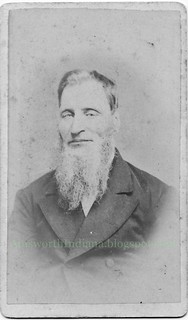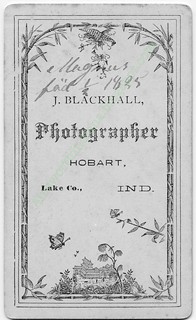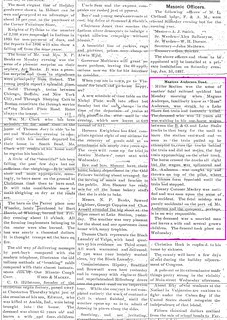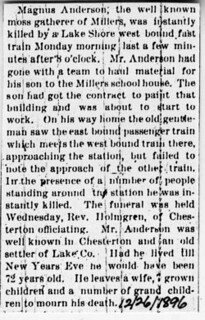
(Click on images to enlarge)

On that ornately printed back, we find two manuscript lines:
MagnusAt first I thought it was a name and a birthdate, but via online translation, we learn that the Swedish word for born is född. Fäd translates to something like fading.
fäd 1/2 1825
And yet … there is no reason why a Swedish-speaking person could not make a spelling error as easily as an English-speaking person. And what else could the writer possibly have meant?
If we assume that this is a birthdate, then the writer apparently has identified the subject of the photo as a man named Magnus, born on 1 February 1825. Do the census records turn up anyone of that description in the Hobart area?
Why, yes, they do. The 1860 Census shows a 35-year-old blacksmith named Magnus Anderson living in Hobart Township with his wife, Mary, and three children. No one else of that age, with either the first or last name of Magnus, shows up in the area.
I can't find Magnus Anderson in the 1870 Census, but I think I've found him in the 1880 Census — in North Township, age 55, wife named Mary (but her age is off by about three years). While none of the children from 1860 are still in the household, you wouldn't necessarily expect them to be. Magnus is no longer a blacksmith; now he is a "farmer and moss gatherer."
With no 1890 census records available, the next news I have of Magnus is his death, which occurred in Miller. This is what the Hobart Gazette of Dec. 25, 1896, reported:

Slightly more informative is this article from the Chesterton Tribune of Dec. 26, 1896 (downloaded from findagrave.com):

The penultimate sentence gives us a birthdate: January 1, 1825 (if not December 31, 1824). A New Year's Day (or Eve) birthday is certainly memorable … so why didn't the person writing on the back of the photograph get it right?
As much as I'd like to think the photo really is Magnus Anderson, that identification requires two assumptions: (1) that the manuscriptor didn't know how to spell "born"; and that (2) either (a) the manuscriptor couldn't remember that Magnus was born on New Year's Day, for goodness' sake; (b) the Chesterton Tribune got his birthday wrong; or (c) Magnus had gone around telling people he was born on New Year's Day because it was more interesting than being born on February 1, and the manuscriptor alone knew the truth.
Those are pretty big assumptions! I think I still have to classify this photo as unidentified.

3 comments:
You're right about född meaning born and I think I can make it make a little more sense. That is probably an ö not an a in their writing and they probably just didn't write out the full word "födelsedag" which means birthday. To me it looks like a d and l running together at the end there.
Thank you for the Swedish lesson! And for backing up my theory. I like people who back up my theories. :)
Lol you're welcome.
Post a Comment